How Can Mobile Brands Improve Customer Retention and Conversion Rates With Sentiment Analysis

Reading Time: 5 minutes
Making improvements to your product or services based on customer feedback takes a significant amount of time. To understand your customer’s likes and dislikes, you will need to deep-dive through many reviews to get an overall idea of their opinions. This article explains a quicker, easier way to collect actionable insights from the reviews section with the simple process of Sentiment Analysis. Through this process, you will also learn how you can improve customer retention via Sentiment Analysis.
Learn:
|
What is Sentiment Analysis?
Sentiment Analysis (also known as opinion mining) is a natural language processing approach for determining the positive, negative, or neutral nature of textual data. It is used to track brand and product sentiment in consumer feedback and better understand customer requirements.
Sentiment Analysis is an automatic process that analyses textual data derived from reviews, social media comments, long and short-form posts, and more. Conducting Sentiment Analysis on qualitative data allows you to extract valuable information, thus making it quantitative.
What are the advantages of Sentiment Analysis?
- Improve the timeliness and efficiency of analyzing data at a large scale.
- Helps mobile brands make better-informed decisions on appreciated features by consumers and ones that are not.
- Enables brands to understand issues in real-time.
- Explains emotions one-dimensionally, thus preventing them from being perceived differently by each person.
How can you leverage reviews and ratings on the Google Play Store and the App Store?
As you’re already aware, your customers can rate your mobile app between 1 to 5 stars on Google Play and the App Store, depending on their opinions and preferences. They are only allowed to rate an app once but can update or change their ratings and reviews as they see fit.
Both Google Play and the App Store allow you to reply to the reviews to create a better user experience. If the review can be addressed and resolved, it might lead to a user improving their review, thus improving the sense of loyalty of the user. If the messaging is kept consistent on all platforms, it will enhance your business’s retention rates. The tricky part of keeping track of the reviews and ratings is that for a developer to understand and analyze such vast quantities of unorganized data, it takes quite a bit of time.
Here is where the concept of Sentiment Analysis comes into play.
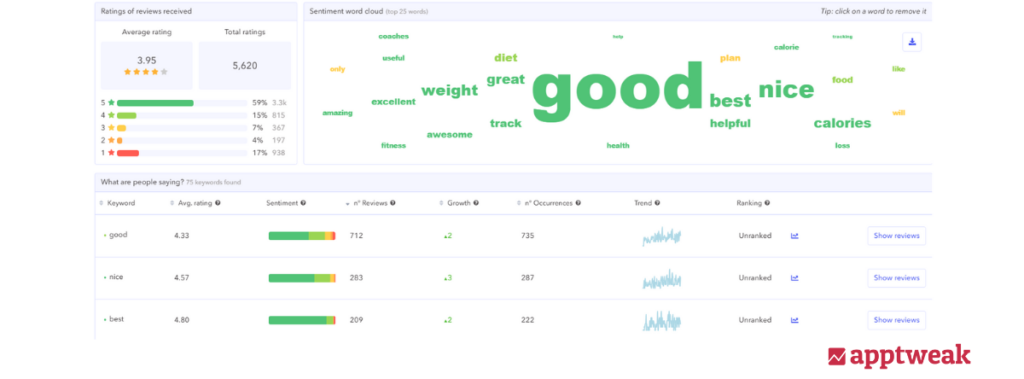
How to conduct Sentiment Analysis
Let’s show you how you can conduct Sentiment Analysis by taking the example of positive and negative analysis with Swiggy, India’s leading on-demand food delivery platform. The app has an average rating of 4.2 on the Google Play Store.
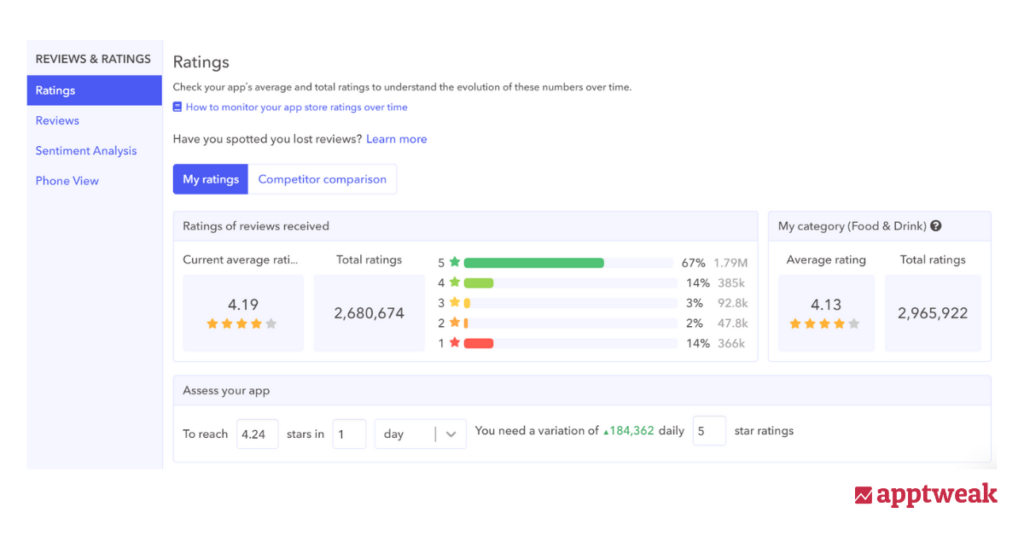
An integral part of Swiggy’s app marketing strategy involves consistently replying to their customers’ reviews and ensuring that their customer success team resolves any issues that appear via email.
Most Positive Keywords
In order to understand the positive sentiments that Swiggy’s customers have expressed, we start by analyzing the most frequently used positive keywords in Swiggy’s reviews and rating section. This also helps indicate features that are being well appreciated.
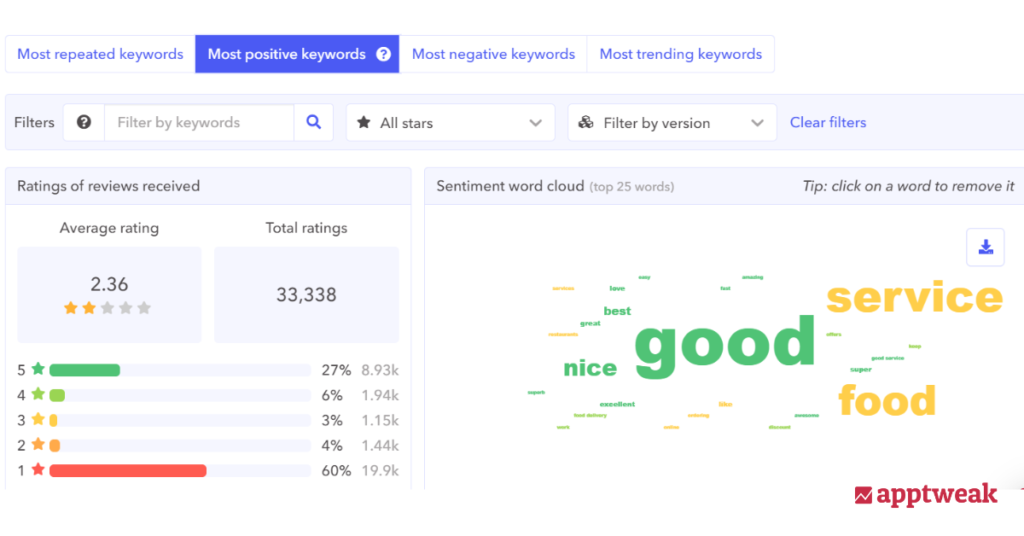
Customers who leave positive sentiments are more likely to do it again if encouraged. The app review section is a vital touchpoint to analyze brand loyalty, as the customer’s positive experience can help guide your future brand strategies.
Most Negative Keywords
Let’s analyze the most frequently used negative keywords in Swiggy’s reviews and rating section. We get an overall view that helps us understand customers’ negative sentiments towards specific features of the app.
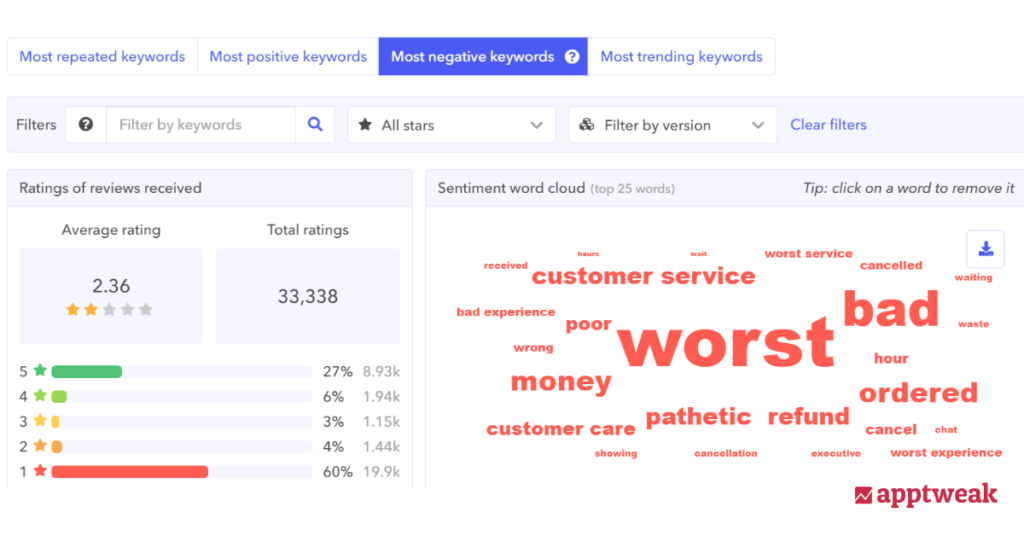
While at first glance negative reviews often appear to be harmful, they provide valuable insight into why a customer would leave your app. Understanding the most common customer pain points allows you to address them, making it an integral step towards improving user retention.
Remember to respond to these customers. It’s critical not to disregard unfavorable feedback. You may respond to any review straight from the AppTweak interface. Responding to your users demonstrates to other potential consumers that you value your customers’ input.
Sentiment Analysis aims to reduce the time needed to identify potential issues that may lead to a drop in visibility and downloads. It is a proactive approach to a root-cause analysis that can save time, energy, and money. When allowed to exist and build, negative sentiments can impact an app’s visibility and rank on specific keywords and throughout the store.
While performing Sentiment Analysis, it is also important to analyze the most positive keywords with the highest average rating.
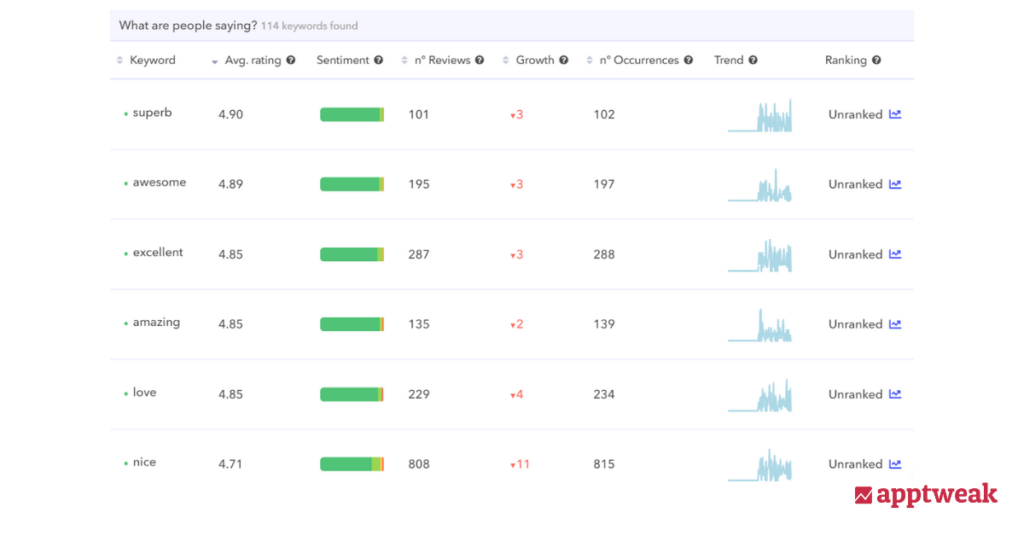
This table of Swiggy’s most positive keywords shows us the number of times each keyword was used in a review, along with the average rating associated with that word. We can also observe the growth of each term over a certain predetermined period. If a word recently appears to be trending, this indicates that a possible new feature might need to be addressed, depending on the sentiment attached to it. If it is positive, the feature can take a higher priority over others in your app listing. If it is negative, the product team can look into how it can be improved.
How does Sentiment Analysis lead to higher customer retention?
Conducting Sentiment Analysis is one of the fastest ways to comprehend real-time feedback.
One of the objectives of performing and reacting to Sentiment Analysis is to increase customer retention and fix issues that may be causing current customers to rate the app low and/or leave a bad review. Acknowledging them helps to provide the product team with direction, proving to be a vital branding exercise.
To increase an app’s loyalty and retention, marketers must ensure that the app delivers the brand promise. If multiple reviews highlight that the app’s functionality is not the same as advertised, your app is likely to have a low retention rate. Keeping your consumers at the center of your business decisions leads to many advantages.













